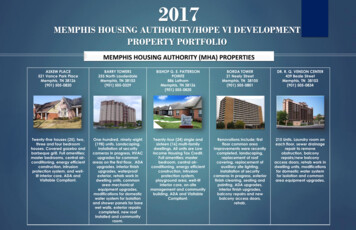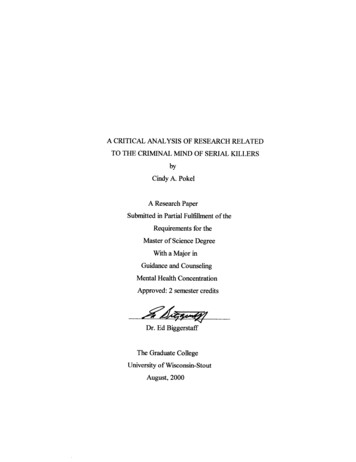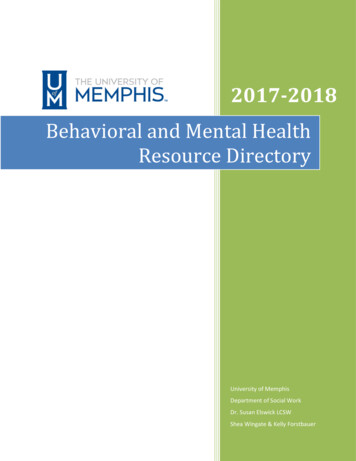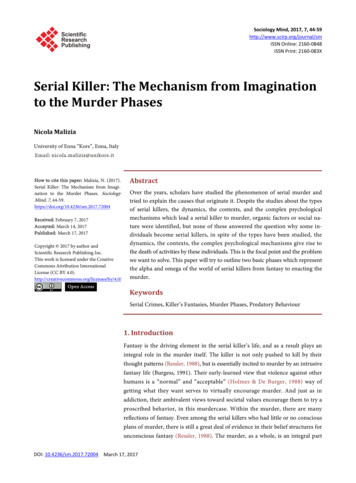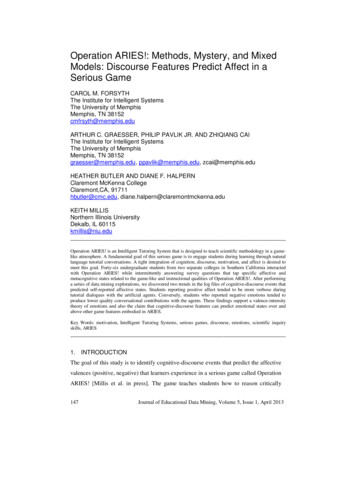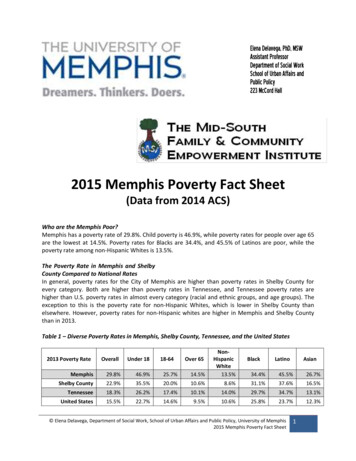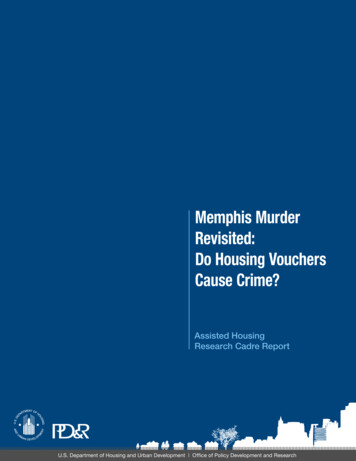
Transcription
Memphis MurderRevisited:Do Housing VouchersCause Crime?Assisted HousingResearch Cadre ReportU.S. Department of Housing and Urban Development Office of Policy Development and Research
Memphis Murder Revisited:Do Housing Vouchers Cause Crime?Prepared for:U.S. Department of Housing and Urban DevelopmentOffice of Policy Development and ResearchAuthors:Ingrid Gould EllenMichael C. LensKatherine O’ReganWagner School and Furman Center, New York UniversityFebruary 2011Assisted HousingResearch Cadre Report
ACKNOWLEDGMENTSWe appreciate the helpful guidance and comments provided by staff in the Policy Developmentand Research Division of the U.S. Department of Housing and Urban Development (especiallyDavid Chase, Barbara Haley, Mark Shroder, and Lydia Taghavi), as well as the data assistancefrom Robert Gray at Econometrica, Inc., and guidance from Olga Nacalaban at the QED Group.We also thank Emily Osgood and Alan Biller for research assistance and our colleagues atNYU’s Furman Center for Real Estate and Urban Policy for their useful insights andsuggestions.DISCLAIMERThe contents of this report are the views of the contractor and do not necessarily reflect the viewsor policies of the U.S. Department of Housing and Urban Development or the U.S. Government.
Memphis Murder Revisited: Do Housing Vouchers Cause Crime?PrefaceAlthough the size of the Housing Choice Voucher (HCV) program has increased to over 2.2million units by 2008, communities sometimes oppose vouchers because of concerns thatvoucher recipients will both reduce property values and heighten crime. Hanna Rosin gave voiceto the latter worries in her widely-read article, “American Murder Mystery,” published in theAtlantic Monthly in August 2008. Despite the publicity, virtually no research systematicallyexamines the link between the presence of voucher holders in a neighborhood and crime.For this report, Memphis Murder Revisited: Do Housing Vouchers Cause Crime?, theresearchers attempted to find evidence that an increase in the number of voucher holders in atract leads to more crime. They found that crime in a year tends to be higher in census tracts withmore voucher households that year, but that positive relationship disappears when they controlfor last year’s crime rate or crime trends in the broader sub-city area. There is strong evidence forthe reverse causal story, however. That is, the number of voucher holders in a neighborhoodtends to increase in tracts with rising crime, suggesting that voucher holders are more likely tomove into neighborhoods when crime rates are increasing.Longitudinal, neighborhood-level crime and voucher utilization data in 10 large U.S. cities arethe data that were used to examine whether additional voucher holders lead to elevated rates ofcrime. The unique set of annual, neighborhood-level crime data covers portions of the 1995 to2008 period. The researchers used crime data for each of the 14 years for three cities (Austin,Chicago, and Indianapolis) and crime data for all but one year in Cleveland, Denver, and Seattle.For all other cities, they used crime data for between five and eight years.The heart of the report is a set of regression models of census tract-level crime that test whetheradditional voucher holders lead to elevated rates of crime. The models control for the presence ofother subsidized housing, demographic characteristics of census tracts that change over time, andcensus tract fixed effects, which capture unobserved, pre-existing differences betweenneighborhoods that house large numbers of voucher households and those that do not. Somemodels also control for neighborhood crime in the prior year and for broader crime trends.Finally, they also test for the possibility that voucher holders tend to settle in higher crime areas.iii
Memphis Murder Revisited: Do Housing Vouchers Cause Crime?TABLE OF CONTENTSEXECUTIVE SUMMARY . viI. INTRODUCTION . 1II. THEORY AND PRIOR LITERATURE . 1Theoretical Mechanisms . 1Empirical Evidence on Subsidized Housing and Crime . 3III. DATA AND METHODS . 4Descriptive Statistics . 6Methods . 7IV. RESULTS . 10V. CONCLUSION . 16REFERENCES . 18ENDNOTES . 20APPENDIX A: DATA . 21APPENDIX B: MAPS . 28iv
Memphis Murder Revisited: Do Housing Vouchers Cause Crime?LIST OF TABLESTable 1: Crime data by city by year . 5Table 2: Average tract characteristics . 7Table 3: Baseline regression results . 11Table 4: Testing causality #1 . 13Table 5: Testing causality #2 . 14Table 6: Regression results: testing for non-linearities . 15v
Memphis Murder Revisited: Do Housing Vouchers Cause Crime?Executive SummaryThe size of the Housing Choice Voucher (HCV) program has increased significantly overthe course of its existence.* For instance, in 1980, the traditional public housing program wastwice the size of the rental certificate program (“HCV predecessor”), but that shifted over time asthe rental certificate program grew in popularity and as there was a shift in federal housingstrategy from locally owned public housing to privately owned rental housing. By 2008, thevoucher program was almost twice the size of the public housing program. There were 2.2million vouchers nationwide in 2008, compared to 1.2 million public housing units.Although the academic and policy communities have welcomed this shift, communityopposition to vouchers can be fierce (Galster et al. 2003). Local groups often express concernthat voucher recipients will both reduce property values and heighten crime. Hanna Rosin gavevoice to the latter worries in her widely-read article, “American Murder Mystery,” published inthe Atlantic Monthly in August 2008. Despite the publicity, however, there is virtually noresearch that systematically examines the link between the presence of voucher holders in aneighborhood and crime. Our paper aims to do just this, using longitudinal, neighborhood-levelcrime and voucher utilization data in 10 large U.S. cities. We use census tracts to representneighborhoods.The heart of the report is a set of regression models of census tract-level crime that testwhether additional voucher holders lead to elevated rates of crime, controlling for the presenceof other subsidized housing, census tract fixed effects—which capture unobserved, pre-existingdifferences between neighborhoods that house large numbers of voucher households and thosethat do not—and demographic characteristics of census tracts that change over time. In somemodels, we also control for crime in the neighborhood in the prior year and for trends in crime inthe city or broader sub-city area in which the neighborhoods are located. Finally, we also test forthe possibility that voucher holders tend to settle in higher crime areas.In brief, we find little evidence that an increase in the number of voucher holders in atract leads to more crime. We do find that crime in a year tends to be higher in census tracts withmore voucher households that year, but that positive relationship disappears after we control forlast year’s crime rate or crime trends in the broader sub-city area. There is strong evidence forthe reverse causal story, however. That is, the number of voucher holders in a neighborhoodtends to increase in tracts with rising crime, suggesting that voucher holders are more likely tomove into neighborhoods when crime rates are increasing.*The HCV program began as the Section 8 existing housing program or rental certificate program in 1974. As therental certificate program grew in popularity, Congress authorized the rental voucher program as a demonstration in1984 and later formally authorized it as a program 1987. The rental certificate program and the rental voucherprogram were formally combined in the Quality Housing and Work Responsibility Act of 1998. Throughconversions of rental certificate program tenancies, the HCV program completely replaced the rental certificateprogram in 2001. (Background information on the HCV program was condensed from U.S. Department of Housingand Urban Development, Office of Public and Indian Housing (1981), Housing Choice Voucher ProgramGuidebook. Washington, DC: U.S. Department of Housing and Urban Development, pgs 1-2 through 1-5.)vi
Memphis Murder Revisited: Do Housing Vouchers Cause Crime?I.IntroductionThe size of the Housing Choice Voucher (HCV) program has increased significantly over thecourse of its existence.i For instance, in 1980, the traditional public housing program was twicethe size of the rental certificate program (“HCV predecessor”), but that shifted over time as therental certificate program grew in popularity and as there was a shift in federal housing strategyfrom locally owned public housing to privately owned rental housing. By 2008, the voucherprogram was almost twice the size of the public housing program. There were 2.2 millionvouchers nationwide in 2008, compared to 1.2 million public housing units.Although the academic and policy communities have welcomed this shift, communityopposition to vouchers can be fierce (Galster et al. 2003). Local groups often express concernthat voucher recipients will both reduce property values and heighten crime. Hanna Rosin gavevoice to the latter worries in her widely-read article, “American Murder Mystery,” published inthe Atlantic Monthly in August 2008. Despite the publicity, however, there is virtually noresearch that systematically examines the link between the presence of voucher holders in aneighborhood and crime. Our paper aims to do just this, using longitudinal, neighborhood-levelcrime and voucher utilization data in 10 large U.S. cities. We use census tracts to representneighborhoods.The heart of the report is a set of regression models of census tract-level crime that testwhether additional voucher holders lead to elevated rates of crime, controlling for the presenceof other subsidized housing, census tract fixed effects—which capture unobserved, pre-existingdifferences between neighborhoods that house large numbers of voucher households and thosethat do not—and demographic characteristics of census tracts that change over time. In somemodels, we also control for crime in the neighborhood in the prior year and for trends in crime inthe city or broader sub-city area in which the neighborhoods are located. Finally, we also test forthe possibility that voucher holders tend to settle in higher crime areas.In brief, we find little evidence that an increase in the number of voucher holders in atract leads to more crime. We do find that crime in a year tends to be higher in census tracts withmore voucher households that year, but that positive relationship disappears after we control forlast year’s crime rate or crime trends in the broader sub-city area. There is strong evidence forthe reverse causal story, however. That is, the number of voucher holders in a neighborhoodtends to increase in tracts with rising crime, suggesting that voucher holders are more likely tomove into neighborhoods when crime rates are increasing.II.Theory and Prior LiteratureTheoretical MechanismsLocal residents often oppose the construction of subsidized rental housing or the arrivalof new housing voucher holders, voicing concerns that the new residents will bring with themelevated rates of crime. While the fears are not always well-articulated, the entry of voucherholders could theoretically lead to crime in a neighborhood. There are at least four mechanismsthrough which the presence of voucher households might influence local crime rates. First, both1
Memphis Murder Revisited: Do Housing Vouchers Cause Crime?economists (Becker 1968) and sociologists (Agnew 1992; Merton 1938) have developed robusttheories explaining why economically distressed households might be more likely to engage incriminal activity. In Merton’s widely cited genesis of “strain theory,” poverty leads to antisocialand criminal behavior in societies where poverty, limited opportunity, and shared symbols ofsuccess produce pressure or “strain” to achieve economic mobility that can lead to deviantbehavior. As for the economic perspective, Becker’s criminal is a rational actor who weighs thecosts and benefits of committing crimes. More impoverished individuals have much more to gain(and less to lose) from criminal activity. In each case, poor individuals will be more likely tocommit crimes, and crime will be higher in higher poverty neighborhoods. Indeed, concentrateddisadvantage can lead to even higher crime rates than expected given the level of poverty, due toa breakdown of social norms and reduced efficacy on the part of residents to organize againstcriminal elements. (Or in a refinement of the theory, some have suggested that increases inpoverty rates in a community will lead to crime once poverty rates reach a certain threshold levelor tipping point (Galster 2005).) Empirically, many studies have found a connection betweenfamily income and the likelihood that members of that family will be involved in criminalactivity and/or a relationship between the poverty rate in a neighborhood and the crime rate(Hsieh and Pugh 1993; Krivo and Peterson 1996; Hannon 2002; Bjerk, 2007; Stults 2010).Hsieh and Pugh (1993) provide a useful meta analysis, summarizing much of this work.Given this relationship between poverty and crime, we would expect crime rates to rise ina neighborhood when voucher holders move in if the voucher holders have lower incomes thanthe previously existing residents. Alternatively, if poverty only matters above a certain threshold,we might expect crime to increase if the number of voucher holders in a tract reaches a certainlevel of concentration.Second, voucher holders may increase not only poverty in a neighborhood but alsoincome diversity or inequality. Many studies of neighborhood crime find that greater incomeinequality leads to more crime (Hipp 2007; Hsieh and Pugh 1993; Sampson and Wilson 1995).Hipp (2007), in a cross-sectional analysis of census tract-level crime data in 19 cities, finds thatthe significant association between crime and poverty might actually be picking up a more robustrelationship between inequality and poverty. Some posit that this relationship exists becausewealthier households and their property present targets to low-income households. Others haveargued that neighborhoods containing people of diverse backgrounds and limited sharedexperiences and perspectives are typically characterized by greater social disorganization, whichcan reduce social control and lead to increases in crime (Shaw and McKay 1942).Third, a growth in the voucher population might simply increase turnover in acommunity, which may also lead to elevated crime through social disorganization, as socialnetworks and norms are broken down. Of course, the in-movement of voucher households can beboth a cause and a symptom of residential instability, as larger out-migration from aneighborhood opens up opportunities for voucher holders.Finally, Rosin (2008) proposes a fourth mechanism, suggesting that housing voucherholders who have moved from demolished public housing developments often take with themthe gang and other criminal networks that they developed there. There is considerable evidencethat crime rates are abnormally high in many public housing developments (Goering et al 2002;Hanratty, McLanahan, and Pettit 1998; Rubinowitz and Rosenbaum 2000). Thus it is possiblethat residents using vouchers to leave public housing are more likely to commit crimes—or havefriends who are more criminogenic—than the individuals already living in the voucher holders’chosen destination neighborhoods.2
Memphis Murder Revisited: Do Housing Vouchers Cause Crime?In sum, there are a number of relevant theories that suggest that a growth in the numberof housing voucher households in a neighborhood could lead to an increase in crime. Thesemechanisms, and much of the extant literature analyzing these effects, suggest that thehypothesis that additional voucher households in a neighborhood could increase crime is aplausible one. However, none of these studies have directly tested the affect that vouchers orother subsidized households have on neighborhood crime rates, which is the focus of this paper.In the next section, we will summarize the empirical evidence from the studies that have directlyestimated these effects.Empirical Evidence on Subsidized Housing and CrimeThere are several papers exploring the effect that other types of subsidized housing haveon crime. Most estimate the simple association between the presence of traditional publichousing and neighborhood crime. As noted already, many studies find that distressed publichousing developments have extremely high levels of crime (Goering et al 2002; Hanratty, Pettit,and McLanahan 1998; Rubinowitz and Rosenbaum 2000). But studies that examine therelationship between crime and public housing more generally find more mixed results. Roncek,Bell, and Francik (1981), for example, examine the areas surrounding 17 public housingdevelopments in Cleveland, and find that nearby blocks have significantly higher crime ratesthan other blocks, and that the size of the housing project is related to the block-level crime rate.However, when they control for other socioeconomic variables, they find that proximity topublic housing was only a minor factor contributing to a block’s crime rate.Farley (1982) examines crime data in St. Louis from 1971 to 1977 in the areas thatcontain the city’s ten largest public housing developments. He finds that the crime rates on theblocks containing public housing are no different from what would be expected given thedemographic composition of these areas.McNulty and Holloway (2000) use crime data from 1990 to 1992 and 1990 census andpublic housing data to examine race, public housing, and crime in 435 Atlanta block groups. Theauthors find that neither proximity to public housing nor racial composition is correlated withcrime rates, but areas with public housing and largely black populations have significantly higherviolent crime rates, suggesting an interactive effect between race and public housing.Perhaps more relevant to our analysis, a few studies actually study how the creation ofnew subsidized housing affects crime levels. For example, Goetz, Lam, and Heitlinger (1996)examine how converting and creating scattered-site public housing affects crime in thesurrounding neighborhoods of Minneapolis. The authors find that police calls from thedevelopments’ locations actually decrease after the creation of the new subsidized housing.However, they also find some evidence that as the developments age, nearby crime increases.Galster et al. (2003) also study how scattered-site public housing affects crime usingtime-series data. The authors find no evidence that the creation of either dispersed public housingor supportive housing affects crime rates in Denver.Freedman and Owens (2010) look at the extent to which the Low-Income Housing TaxCredit (LIHTC) affects crime at the county level. They exploit a discontinuity in the fundingmechanism for these tax credits to develop a model that allows them to better estimate a causalrelationship between the number of LIHTC developments in a county and crime. They find that3
Memphis Murder Revisited: Do Housing Vouchers Cause Crime?LIHTC developments lead to decreases in violent crime at the county level, but there are noeffects on property crime.One unpublished paper specifically analyzes the effect of voucher locations onsurrounding crime rates. Van Zandt and Mhatre (2009) analyze crime data within a quarter mileradius of apartment complexes containing 10 or more voucher households during any monthbetween October 2003 and July 2006 in Dallas. Unfortunately, the police did not collect crimedata in these areas if the number of voucher households dipped below 10, leading to gaps incoverage and limiting the number and type of neighborhoods examined. Moreover, a consentdecree resulting from a desegregation case mandated that the Dallas Police Department collectthese crime counts, suggesting that the police may have focused crime control efforts on theseareas. The authors estimate a set of spatial regressions, controlling for spatial autocorrelation,and find that clusters of voucher households are associated with higher rates of crime. However,they find that changes in crime have no relationship to the change in the number of voucherhouseholds, suggesting that while voucher households tend to live in high-crime areas, they arenot necessarily the cause of higher crime rates.Van Zandt and Mhatre’s results suggest that reverse causality may confound estimates ofhow voucher presence affects crime. As with many low-income households, voucher holdersface a constrained set of choices when deciding where to live. They can only live inneighborhoods with affordable rental housing, and they may only know about—or feelcomfortable pursuing—a certain set of those neighborhoods, given their networks of social andfamily ties. In addition, they may be constrained by landlord resistance to accepting vouchers.Research on the Moving to Opportunity (MTO) demonstration program shows that landlordattitudes toward voucher holders play an important role in determining whether voucherhouseholds move to and stay in low poverty neighborhoods (Turner and Briggs 2008).Collectively, these constraints may lead voucher households to choose neighborhoods that eitherhave high crime rates or are experiencing increases in crime, due to broader trends ofneighborhood decay. In related work, we find that voucher households occupy neighborhoodswith higher than average crime rates (Lens, Ellen, and O’Regan 2011).ii Thus, in our analysis ofimpacts, we will attempt to control for the fact that voucher holders tend to locate in high crimeareas.Taken as a whole, the empirical evidence on the extent to which voucher householdsaffect neighborhood crime is quite scarce. There is a larger body of literature that analyzes theeffect of other subsidized households on crime, but much of that literature is dated and focuseson large public housing developments, providing limited insight about the extent to whichvoucher households might affect neighborhood crime.III.Data and MethodsWe use a number of different data sources for our analyses, spanning several cities andyears. First, the U.S. Department of Housing and Urban Development (HUD) provided us withhousehold-level data on voucher holders and public housing tenants nationwide from 1995 to2008, which we aggregate to the census tract-level, in order to link to our crime data. Voucherdata are provided to HUD by local housing agencies, and should reflect the count of assistedhouseholds in a census tract as of the end of specified year. Our crime data consist of a uniqueset of annual, neighborhood-level crime data in 10 U.S. cities, which cover portions of the 19954
Memphis Murder Revisited: Do Housing Vouchers Cause Crime?to 2008 period. Table 1 displays the years in which crime data are available in each city. Wehave crime data for each of the 14 years for three cities (Austin, Chicago, and Indianapolis) andcrime data for all but one year in Cleveland, Denver, and Seattle. (In the case of Cleveland, weuse 1997 and 1999 crime data to estimate the missing 1998 crime rates with a linearinterpolation.) For all other cities, we have crime data for between five and eight years.Unfortunately, we are also missing housing voucher data in some years in some cities.We have no data on vouchers for Philadelphia and Seattle data from 2002 through 2006, andincomplete data in Chicago, Cleveland, and Indianapolis for 1995 and 1996. Appendix TableA—1 displays the tract counts by city and year for the 10 cities in the sample.Table 1: Crime data by city by napolis***XXXXXXXXXNew YorkPhiladelphia**PortlandSeattleXXWashington, XXXXXXXXXXXXXXXXXX*Crime available at the neighborhood-level, where neighborhoods are typically aggregates of two or threecensus tracts.**No homicide or rape data.***Crime data missing for half of the tracts. The tracts included represent just under half of Indianapolis’population.Crime data were collected from one of three sources: directly from police departmentweb sites or data requests to the department (Austin, New York, and Seattle), from researcherswho obtained these data from police departments (Chicago and Portlandiii), and from theNational Neighborhood Indicators Partnership (NNIP) —a consortium of local partnerscoordinated by the Urban Institute to produce, collect, and disseminate neighborhood level data(Cleveland, Denver, Indianapolis, Philadelphia, and Washington, DCiv). For all cities exceptPhiladelphia, we include all property and violent crimes categorized as Part I crimes under theFederal Bureau of Investigation’s Uniform Crime Reporting System.v In all cities except forDenver, neighborhoods are proxied by census tracts. (Denver crime data are aggregated tolocally defined neighborhoods, which are typically two to three census tracts.)We merged tract-level counts of voucher and public housing households to the crime dataand created a panel data set spanning the city-years for which we have tract-level crime data andhousing assistance data. We have access to only a limited number of control variables that are5
Memphis Murder Revisited: Do Housing Vouchers Cause Crime?available annually at the census tract level, but we have collected a number of variables that wethink may help to provide a more precise estimate of the relationship between voucher locationsand crime. First, we control for the number of public housing and Low Income Housing TaxCredit (LIHTC) units in a tract in a given year, using the data provided by HUD. Second, wecontrol for tract-level demographic characteristics, including the poverty rate, homeownershiprate, and racial composition using decennial census data and the American Community Survey(ACS). Because these data are only available for 1990, 2000, and 2005 to 2009 (average), welinearly interpolate the decennial and ACS data, using the bookend years.vi We also includecensus tract fixed effects to control for time-invariant differences across census tracts, andinclude separate year dummy variables for Census Public Use Microdata Areas (PUMAs) tocontrol for crime trends in larger, sub-city areas. Note that PUMAs are substantially larger thancensus tracts. PUMAs house at least 100,000 people, while census tracts house about 4,000people on average.Working with administrative data brings some challenges. The data on subsidizedhouseholds are household-level files that come to HUD from local housing agencies, and assuch, are subject to potential data quality inconsistencies across these different data collectingentities. Particularly in the early years of the data set, HUD was not able to geocode all of theaddresses collected by the housing authorities. HUD researchers estimate that the tract ID ismissing and irretrievable for about 15 to 20 percent of the cases from about 1995 to 1997, butthis gradually improves over the time period to about six percent of the cases by 2008. We haveno way to account for fluctuations in voucher counts that are attributable to missing data in agiven year. We drop the city-years where obvious undercounts occurred, as discussed above.While these coverage gaps will add measurement error, we do not expect that they are related inany way to neighborhood crime.Descriptive StatisticsTable 2 displays population-weighted means for the full sample of census tract-years. Theaverage crime rate was about 74 crimes per 1000 persons, with substantial variation. As acomparison, the 2000 crime rate for all core cities of metropolitan
Memphis Murder Revisited: Do Housing Vouchers Cause Crime? iii Preface Although the size of the Housing Choice Voucher (HCV) program has increased to over 2.2 million units by 2008, communities sometimes oppose vouchers because of concerns that voucher recipients will both reduce property values and heighten crime. Hanna Rosin gave voice
